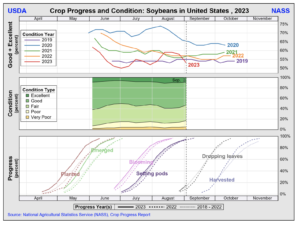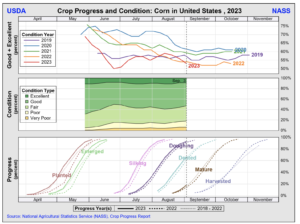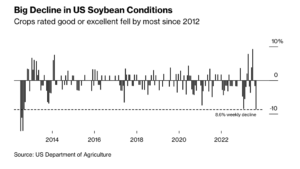Congress has quickly engaged in putting together potential aid packages for farmers that would more than double the Trump administration's $12 billion under the Farmer Bridge Assistance (FBA) Program.
U.S. Corn, Soybeans Good-to-Excellent- “Lowest For This Time of Year Since 2012”
Reuters News reported today that, “Chicago soybean futures rose on Wednesday, recouping the last session’s losses, after a weekly U.S. report showed that crop conditions had deteriorated more than expected due to high temperatures.”

The Reuters article stated that, “The U.S. Department of Agriculture (USDA), in a weekly crop progress report, rated 53% of the U.S. soybean crop as good to excellent, down 5% from a week ago and below the 55% expected on average by 11 analysts surveyed by Reuters.

“The USDA rated 53% of the U.S. corn crop as good to excellent, down 3% from last week and beneath analysts’ expectations of 54%.
#Illinois Topsoil Moisture, @usda_nass pic.twitter.com/nJSv6usMrl
— FarmPolicy (@FarmPolicy) September 5, 2023
“The good-to-excellent ratings for both crops are the lowest for this time of year since 2012, a historic drought year. They have renewed concerns about yields, particularly for soybeans, which are at a critical phase of development.”
30- Day Percent of Normal Precipitation pic.twitter.com/0BaLCheBPC
— FarmPolicy (@FarmPolicy) September 5, 2023
Bloomberg writers Michael Hirtzer and Dominic Carey reported yesterday that, “A worse-than-expected soy harvest could mean fewer beans to crush for animal feed and oil that goes into making renewable fuels.”

Elsewhere, Dow Jones writer Kirk Maltais reported yesterday that, “U.S. export inspections of corn and wheat fell back for the week ended Aug. 31, according to government data.”
The article noted that, “For the 2022/23 marketing year, corn inspections are down 32% from the prior year, while soybean inspections are down over 8% and wheat is down nearly 24%. The gap in wheat inspections has grown in recent weeks.”
Meanwhile, Bloomberg writers Kateryna Choursina and Megan Durisin reported today that,
A drone strike damaged Ukraine’s grain infrastructure on the Danube River overnight, the latest in a raft of attacks on the country’s key crop-export channel.
“Russian drones hit grain elevators near the port of Izmail in the three-hour attack, and one worker from an agriculture company was killed, according to Odesa regional governor Oleh Kiper. Fifteen drones were shot down in the region, the city council said on Telegram.”
And Reuters News reported today that, “Russia carried out air strikes on Kyiv and the southern Ukrainian region of Odesa early on Wednesday, killing a civilian and causing a fire and damage at a Danube River port, Ukraine’s military said.
“During a nearly three-hour drone attack on Odesa, several agricultural and port facilities were damaged, and several fires were reported in the Izmail district, an important grain exporting hub on the Danube, said regional governor Oleh Kiper.”
Reuters News reported yesterday that, “President Tayyip Erdogan said Turkey is in close contact with the United Nations on reviving the Black Sea grain initiative and he will discuss it with Secretary-General Antonio Guterres at its general assembly this month, Turkish media reported.”
And a separate Reuters News article yesterday reported that, “Ukrainian agricultural exports rose by 16% in August versus July to 4.3 million metric tons, despite difficulties in logistics and Russian attacks on Ukraine’s main export routes, the UCAB agricultural business association said on Tuesday.
“The union said the August volume included 2.3 million tons of grain, 755,400 tons of oilseeds, 548,900 tons of vegetable oils and 367,300 tons of various meals.
“It said wheat and sunflower oil dominated the volume.”





